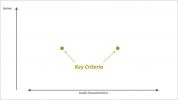So I keep running into companies who send me products with best intentions but miss key aspects that cause me to not recommend. And example is a very nice dongle I recently received that had balanced output but was limited to just 2 volts out. If you don't know, I like to see minimum of 4 volts out from such a port as otherwise, you can find unbalanced dongles at lower cost that do that.
Another example is channel balance issue with had with an AIYIMA amp where there was almost 1 dB differential.
Yet another is expected SINAD for an amplifier. Yes, we don't rate amps on that one number but if SINAD is say, 60 dB, the rest are going to follow.
In many cases decision makers are not knowledgeable in these companies so proudly show me the gear, only then realizing they could have built something better, but didn't.
Note that my focus here is for electronics only. And I am thinking about the fewest key criteria that passes the "acceptable" mark from me, and by implication, from you all. They can do better of course to get higher praise but want to establish what we like to see.
An example for a dongle:
Output voltage: at least 2 volts on unbalanced, 4 volts on balanced.
SINAD: 100 dB or better, 1 kHz, 22.4 kHz bandwidth
SNR at 50mv: 85 dB (?)
SNR at full 2/4 volt output: 110 dB (?)
Output impedance < 1 ohm
Example for Amplifier:
SINAD >= 80 dB
SNR >= 110 dB (?)
Channel balance < 0.5 dB
Crosstalk > 70 dB @20 kHz
This would be presented as general guidelines for companies to adopt (or not). The point of this thread is not to discuss the specifics although you can, but determine if it is time for us to do this. Hate to have companies ready to produce performant products based on objective measurements but not know clearly what those measurements should be.
What say you?


